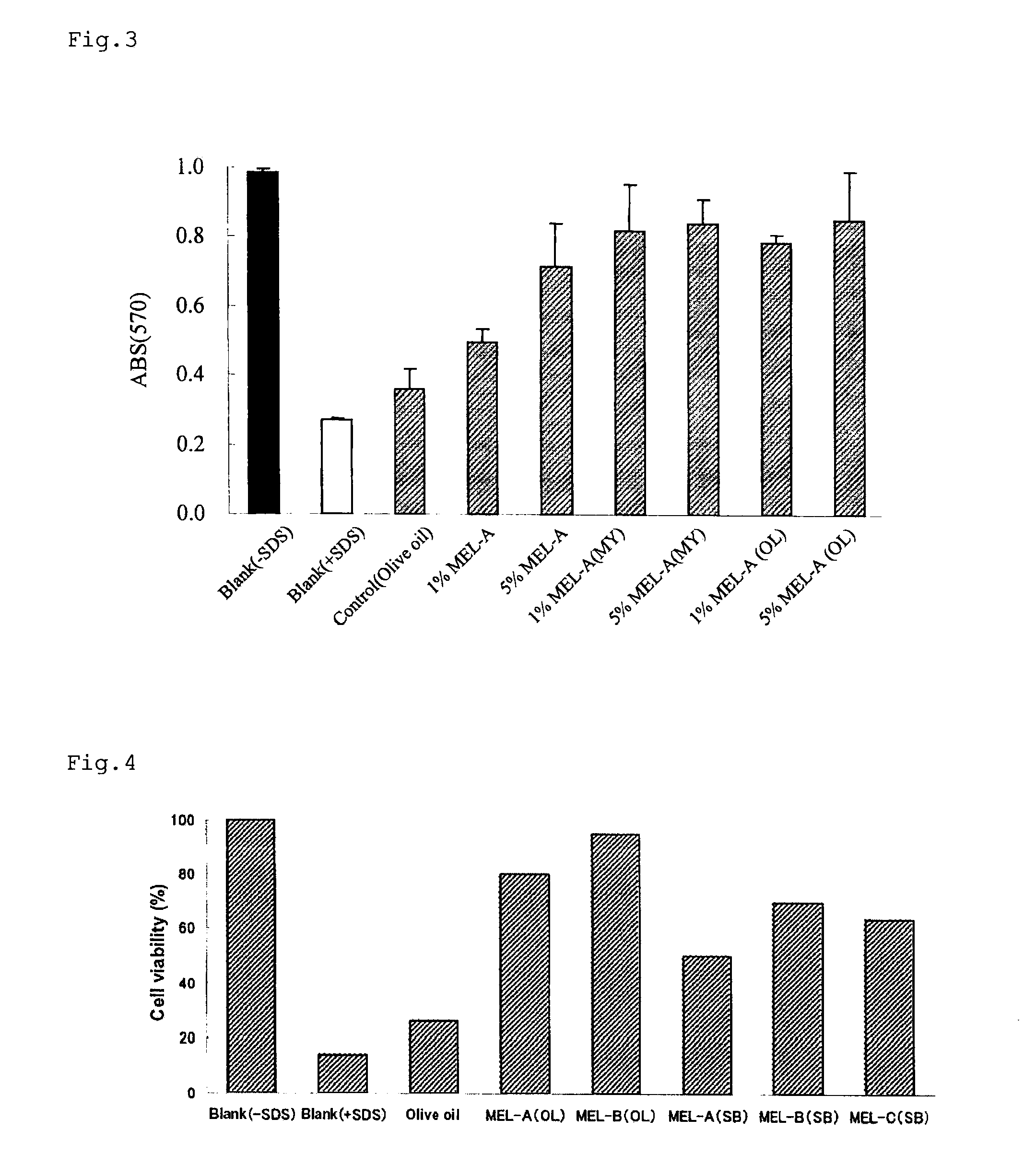Biosurfactant-containing skin care cosmetic and skin roughness-improving agent
a technology of skin care cosmetics and biosurfactants, which is applied in the field of biosurfactant-containing skin care cosmetics and skin roughness-improving agents, can solve the problems of unsatisfactory alternatives to ceramide and high cost of large-scale production, and achieve the effects of improving skin roughness, stable emulsifiers, and improving skin roughness
- Summary
- Abstract
- Description
- Claims
- Application Information
AI Technical Summary
Benefits of technology
Problems solved by technology
Method used
Image
Examples
example 1
Production of MEL
[0069]One loop of Pseudozyma antarctica NBRC 10736 was inoculated in a seed medium (20 mL / 500 mL Sakaguchi flask) to perform an inoculum culture. The culture was performed at 30° C. overnight. The resulting culture medium was rendered in the inoculum. The seed medium was composed of 4% glucose, 0.3% NaNO3, 0.02% MgSO4.H2O, 0.02% KH2PO4 and 0.1% yeast extract. The above inoculum (75 mL) was inoculated in 1.5 L (5 L-jar) of a production medium, and cultured at 30° C., 300 rpm (stirring frequency) and 0.5 L / min0 (air) using the 5 L-jar. A production medium was composed of 3% soybean oil, 0.02% MgSO4.H2O, 0.02% KH2PO4 and 0.1% yeast extract. The culture medium (250 mL) was centrifuged (6,500 rpm, 30 min), a supernatant was removed, and a precipitate (microbial cells) was collected. Ethyl acetate (50 mL) was added to the precipitate, which was then stirred thoroughly and centrifuged (8,500 rpm, 30 min) to separate the supernatant from the precipitate. The supernatant was...
example 1a
Production of MEL-B
[0070]A frozen stock (0.2 mL) of P. tsukubaensis was inoculated in 20 mL of YM seed medium in a 500 mL Sakaguchi flask, and cultured at 26° C. at 180 rpm overnight to make a seed inoculum. The seed inoculum was inoculated again in 20 mL of YM seed medium in a 500 mL Sakaguchi flask, and cultured at 26° C. at 180 rpm overnight to make an inoculum. The inoculum (20 mL) was inoculated in 2 L of YM medium in a 5 L jar and cultured at 26° C. at 300 rpm (¼ VVM, 0.5 L air / min) for 8 days. The culture medium was centrifuged at 7,900 rpm at 4° C. for 60 minutes to separate the microbial cells (including MEL-B) from the supernatant. Ethyl acetate (80 mL) was added to a microbial cell fraction, which was then shaken to be suspended thoroughly and then centrifuged at 7,900 rpm at 4° C. for 30 minutes. An equivalent amount of brine was added to the resulting supernatant, and the mixture was stirred to yield an ethyl acetate layer. An appropriate amount of sodium sulfate anhydr...
example 2
[0071]Although soybean oil was used as the production material in the production of MEL in Example 1, MEL-A, MEL-B and MEL-C are isolated and purified using olive oil as the production material instead, and cultured the same way as in Example 1. The MEL fractions obtained at this time are referred to as MEL-A (OL), MEL-B (OL) and MEL-C(OL), in order to distinguish them from the MEL obtained in Example 1.
PUM
 Login to View More
Login to View More Abstract
Description
Claims
Application Information
 Login to View More
Login to View More - Generate Ideas
- Intellectual Property
- Life Sciences
- Materials
- Tech Scout
- Unparalleled Data Quality
- Higher Quality Content
- 60% Fewer Hallucinations
Browse by: Latest US Patents, China's latest patents, Technical Efficacy Thesaurus, Application Domain, Technology Topic, Popular Technical Reports.
© 2025 PatSnap. All rights reserved.Legal|Privacy policy|Modern Slavery Act Transparency Statement|Sitemap|About US| Contact US: help@patsnap.com



